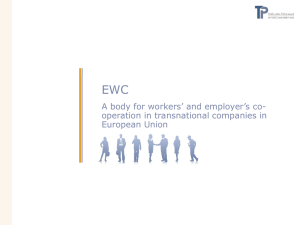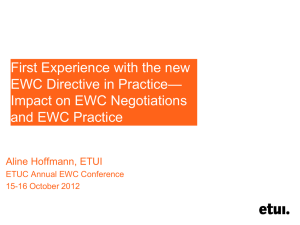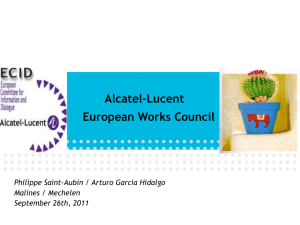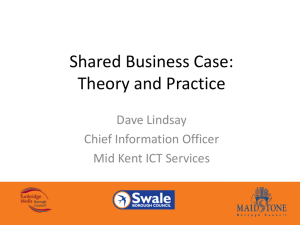here - Employment Law Alliance
advertisement
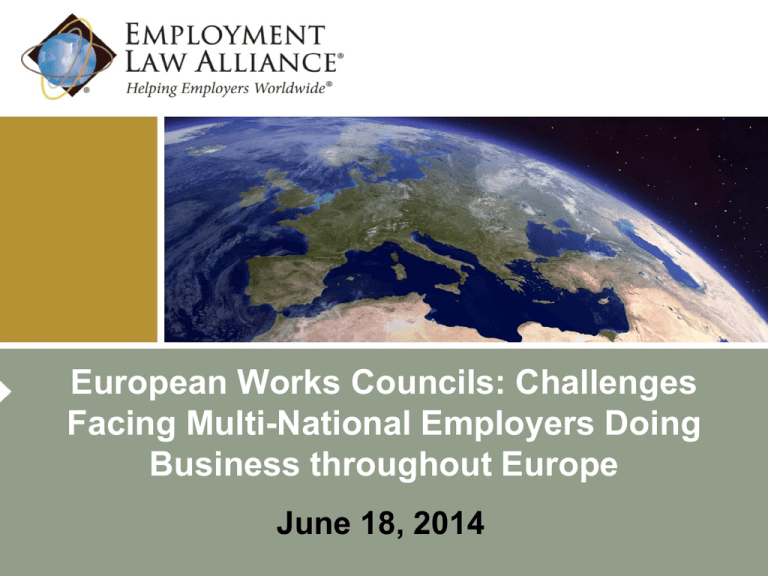
European Works Councils: Challenges Facing Multi-National Employers Doing Business throughout Europe June 18, 2014 Presenters Moderator Jan Tibor Lelley, Partner, Buse Heberer Fromm, Frankfurt, Germany lelley@buse.de 2 Presenters Speakers Sanna Alku, Associate, Castrén & Snellman, Helsinki, Finland sanna.alku@castren.fi Alessandra Deganis, Associate, Grimaldi Studio Legale, Milan, Italy adeganis@grimaldilex.com 3 Presenters Speakers Ghislain Frerejacques, Associate, Fromont Briens, Paris, France ghislain.frerejacques@fromont-briens.com Katalin Furedi, Partner, Gardos, Furedi, Mosonyi, Tomori, Budapest, Hungary furedi.katalin@gfmt.hu 4 Presenters Speakers Sasha Štěpánová, Associate, Kocián Šolc Balaštík, Prague, Czech Republic sstepanova@ksb.com An Van Doorselaer, Senior Associate, Lydian, Brussels, Belgium an.vandoorselaer@lydian.be 5 What Types of Companies Qualify for an EWC? Sanna Alku Castrén & Snellman 6 What Type of Company Qualifies for an EWC? • The legal basis is in the EU Directive 2009/38/EC implemented into the Finnish Law with the Act on Co-operation within Finnish and Community-wide Groups of Undertakings. • The Act applies to a controlling undertaking within a community-wide group of undertakings and to a community-wide undertaking that has been registered in Finland. 7 What Type of Company Qualifies for an EWC? 1) Private or public community-scale company engaged in economic activity – Employing at least 1000 employees in the EU Member States and the other countries of the European Economic Area; and – When there are at least 150 employees in each of at least two Member States. 8 What Type of Company Qualifies for an EWC? 2) Private or public community-scale group of companies engaged in economic activity – Employing at least 1000 employees in the EU Member States and the other countries of the EEA; and – Controlling at least two group undertakings in different Member States, of which each employs at least 150 9 employees. What Type of Company Qualifies for an EWC? • The location of the central management of a community-scale company or group of companies does not have influence on the application of the EWC Directive. • If the central management is situated outside the EU/EEA but the thresholds of 1,000 employees in the EU/EEA and at least 150 in two or more EU Member States are met, the EWC Directive 10 applies. How Is an EWC Established in Your Country? Alessandra Deganis Grimaldi Studio Legale 11 EU Directive 09/38 – Implemented in Italy by Legislative Decree No. 113/2012 • Central management starts the negotiations for establishing an EWC (of its own initiative or upon the request: (i) of the Trade Unions that signed the Collective Bargaining Agreement applied to the company or (ii) upon the request of 100 employees). • A Special Negotiation Body (“SNB”) is set up to decide, together with central management and by means of a written agreement, the area, composition, duration of the EWC, and the tasks assigned to the EWC. 12 EU Directive 09/38 – Implemented in Italy by Legislative Decree No. 113/2012 • Members of the SNB have to be appointed by the Trade Union Organizations that signed the collective agreements applied in the Italian companies, jointly with the Trade Union Representatives ("RSU" or "RSA") constituted in the same companies based in Italy. • The members of the SNB shall be appointed in proportion to the number of employees employed in amounting to 10%, or a fraction thereof, of the overall number of employees employed in the EU. 13 EU Directive 09/38 – Implemented in Italy by Legislative Decree No. 113/2012 • The central management has to negotiate with the SNB. The content of the agreement has to indicate: the companies that are part of the group or the plants subject to the agreement, the composition, number of members, duration of the mandate, tasks assigned to the EWC, the modality of information and consultation, and frequency, place and the time of the meetings. 14 EWC Representatives • The Italian EWC representatives are appointed as follows: − One-third by the trade unions that have executed the National Bargaining Agreement applied to the company. − Two-thirds by the RSU (Rappresentanza Sindacale Unitaria – the unitary trade union delegation) of the company. 15 EWC Representatives • In the establishments and undertakings where there is no RSU, the trade unions that executed the NBA applied by the company should agree with the management on the procedures, criteria and modalities to set up the special negotiation body and the EWC. • An election by the entire workforce is not provided for under the Italian law. 16 Italian Peculiarity • Sec. 5 par. 1 and 6 par. 2 also includes trade unions that entered into the applied National Collective Bargaining Agreement as the body entitled to: (i) ask for the set up of an EWC; (ii) appoint members of the Special Negotiation Body (to set up an EWC). • EWC connection to trade unions that entered into the NCBA applied to the company is an Italian peculiarity. 17 Governing Laws of an EWC Katalin Furedi Gardos, Furedi, Mosonyi, Tomori 18 Governing Law Rules in EU Directive 2009/38 • Central management’s obligation to manage the process – central management’s national law defines its obligations (Article 4). • Election of the members of the special negotiating body (SNB) – national laws of where elected (Article 5(2)(a)). 19 Governing Law Rules in Act XXI of 2003 • Hungarian law applies for: – Collection and transfer of information required for initiating the set up of the SNB Determination of the number of the Hungarian employees; – Election and protection of the representatives of the Hungarian employees; – Obligations of Hungarian employer with respect to the rules of the EWC set up, information and consultation and consequences of their violation. 20 Governing Law Rules in Act XXI of 2003 • Hungarian law applies for Hungarian central management (Hung. EU representative office, etc.) – for: – Initiation of the negotiations and the relevant information obligations (3. §) – Bearing the costs of the set up of the SNB and the negotiations (6. §), (if applicable, 10–23. §) – Rules on the number and structure of the EWC and related information (13–14. §) – Negotiation with the EWC, extraordinary information and negotiations (16–17. §) – Bearing the costs of the EWC operation (18. §, 21/B. §), 21 training (21/B. §) Governing Law Issues • Initiating the set up of the SNB – several national laws apply • Set up of the SNB – several national laws apply • Negotiations – central management’s national law • Agreement on EWC – choice of law − Proactive participation by employer – its interest to minimize costs and maximize efficiency in the set-up process, + possibility to negotiate terms different from subsidiary requirements. 22 Governing Law Issues • Set up and operation of EWC – choice of law or Rome I Regulation − If no agreement and Hungarian law applies: e.g., o Members of EWC are appointed by the local work councils for 3 years; members can be recalled o Limitation on transfer of information is possible without administrative or court decision o Disputes: Hungarian labor court has competence, decision within 15 days in a special court process – limitations? o Confidentiality rules – detailed ones, but no liability rules – which law applies for damages? 23 Comparison of Competence between EWC and National WC Ghislain Frerejacques Fromont-Briens 24 The Functions of Each Works Council • EWCs’ functions: either based on the agreement signed to establish the Council or in accordance with Articles L2343-2 to 4 of the French labour Code (subsidiary requirements). • National Works councils’ functions are much more extensive, at least insofar as a collective agreement does not extend the functions of the EWC. 25 Coordination between EWCs and National Works Councils • Coordination can be defined by the agreement; otherwise the WC must be informed and consulted whenever the EWC has competence. – Main question for negotiators is to determine which body should be consulted first or how to arrange parallel consultation 26 Coordination between EWCs and National Works Councils • Information provided to the WC may be not sufficient for the purpose of EWC’s consultation (Cass. Soc., Jan 16th 2008). • If an expert is requested by the EWC, the WC can wait for the results to deliver its opinion (TGI Paris, Oct 10th 2003). 27 Which Body Must Be Informed/Consulted First? • According to the transposition of Directive 2009/38 (Ord 2011-1328), unless the agreement says otherwise, there is no specific order. • TGI, paris Apr 26th 2009: a “principal of consistence” imposes to consult the EWC first in order to provide national WC with the best information. − Choice made by management is related to effet utile of information/consultation procedure 28 What Is at Stake? • If order of priority between EWC and WC is considered inconsistent, the process can be suspended until completion of the consultation as it should have been proceeded (TGI Sarguemmines, Apr 21st 2009). • The judge can force the employer to organise a new meeting for the WC to be fully informed and receive information from the EWC (Cass. Soc., Jan 16th 2008). 29 The Operations of an EWC Sasha Stepanova Kocián Šolc Balaštík 30 Core Duties of an EWC – Information/Consultation/Cross Border Issues • What does EWC Directive 2009/38/EC say about the “Operation of EWC”? • Directive, Recital (7): − “(…) Modernize Community legislation on transnational information and consultation of employees” – Effectiveness, effective decision making – Agreement between Special Negotiating Body (SNB) and central management. 31 Core Duties of an EWC – Information/Consultation/Cross Border Issues – “(…) Ensuring the effectiveness of employees’ transnational information and consultation rights” – Effective meeting, promoting voluntary agreements. • How: properly informed and consulted (Recital (12)), frequent communication (Art. 4.4.), involvement (Recital (14)) • Goal: improving information/ consultation (Art. 1.1). 32 How an EWC Typically Operates • Meetings – Preparation, agenda, frequency – Training – Translation issues • Considerable diversity in practice − “Symbolic” EWCs − “Proactive” EWCs • Resultant impact on how an EWC operates and impacts the company 33 Practical Operation of an EWC – Important Points • Frequency of contact • Representation of management • Degree of centralized management • Engagement of select committees • Joint working groups 34 Key Points for Employers • Avoid disputes and delays in corporate decision-making associated with EWC consultation. • Protect corporate confidentiality in key business decisions. • Manage the complexities associated with the disclosure of sensitive information to the EWC. 35 Key Points for Employers • How many representatives to have on the EWC and the mix of nationalities. • The number of meetings per annum and the venue and controlling costs. • How EWC matters will be communicated back to employees. • Whether to have a small select committee meeting more frequently, its composition and role. 36 Key Points for Employers • Control of meetings - who chairs, how is agenda set, what minuting arrangements apply. • How EWC member training will be managed and funded. • Facilities to be made available to the employee representatives. • How the composition of the body adapts to meet changes in the group or company as businesses are acquired or shed. 37 Involvement of Local Trade Unions + Special Protection against Dismissal An Van Doorselaer Lydian 38 Involvement of Local Trade Unions • Important role for Belgian trade unions: − Request to set up EWC -> by at least 100 employees or their representatives − In Belgium (CBA nr. 101): member(s) of SNB are: • Member(s) of the Belgian WC (if not present: Health and Safety Committee, unless both not present) • Appointed by the members of the Belgian WC (if not present: Health and Safety Committee; if both not present: Trade Union Delegation if JLC (industry) agrees; if none present: all employees) 39 Involvement of Local Trade Unions • Important role for Belgian trade unions: − In Belgium (CBA nr. 101): member(s) of EWC are: • Member(s) of the Belgian WC (if not present: Health and Safety Committee, unless both not present (in which case they must be employee(s)) • Appointed by the members of the Belgian WC (if not present: Health and Safety Committee; if both not present: Trade Union Delegation if JLC (industry) agrees; if none present: all employees) -> Strong links: as members of SNB and EWC are most often also members of Belgian WC (or Health and Safety Committee) 40 Special Protection against Dismissal • Who? – Representatives in the SNB – Representatives in the EWC – Also substitutes • When? – In Belgium (Act of 23 April 1998): from 30 days before appointment until end of mandate 41 Special Protection against Dismissal • Which protection? – Protection and guarantees similar to those provided for representatives by national legislation in country of employment (EU Directive 2009/38/EC) 42 Special Protection against Dismissal • Which protection? (cont’d) – In Belgium: same as members of Belgian WC: • Can be dismissed only after following strict procedure for economic/technical reasons or for serious cause • Penalty: a protection indemnity: – Fixed indemnity of 2 to 4 years’ remuneration, depending on seniority; – Variable indemnity of remuneration until end of mandate (generally max. 4 yrs.) 43 Special Protection against Dismissal • Which protection? (cont’d) – Comments: • Often overlaps: protection indemnities cannot be combined • Does not always overlap: – If no WC/Health and Safety Committee – If local mandate/protection ends before mandate EWC 44 Please Complete Our Survey Please take a few minutes to complete the survey that should appear on your computer screen immediately following the webinar. To listen to this webinar again or to any past ELA webinars, please visit our website at: www.employmentlawalliance.com. The ELA is not authorized to give Continuing Education credit for its webinars; however, a Certificate of Attendance and supporting materials are now posted on the ELA website (click this webinar’s title; the link is on the landing page). Attendees seeking HRCI or SHRM credit should submit the materials directly to HRCI at www.hrci.org or to SHRM at www.shrm.org. 45

